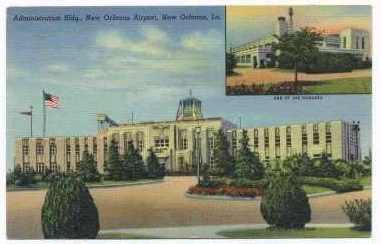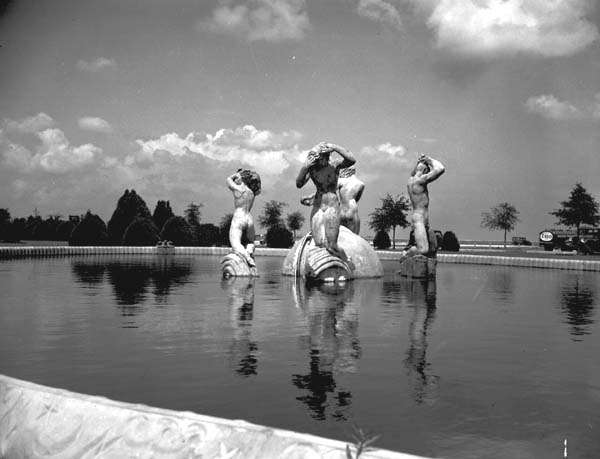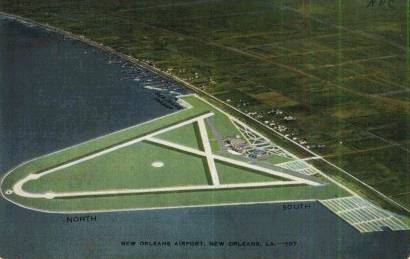|
Today in New Orleans History |
|
|
February 28


 Odd Fellows Rest Cemetery is Dedicated The land for this cemetery was purchased by the
Grand Lodge of the Independent Order of Odd Fellows, a benevolent society, in 1847. The property at 5055 Canal Street, adjoining
St. Patrick Cemetery No. 2 at the intersection of Canal Street and Metairie Road (now City Park Avenue), was purchased for
$700 and later enlarged by donations of land from benefactors and the Firemen’s Charitable Association. It is fortunate
to be situated above the flood plane and has escaped several floods over its history. In 1849, the
new cemetery was dedicated with a large ceremony and a grand procession which bore the cemeteries first 16 remains of former
Odd Fellows members, relocated from other cemeteries. Odd Fellows Rest contains several notable tombs
and monuments. One is for the Howard Association, a group composed of young men whose mission was to provide emergency aid
during the yellow fever epidemic. The tomb features an intricate bas-relief of the organization’s founder, John Howard.
The cast iron gates surrounding the cemetery bear symbols of fraternity tied to the Odd Fellows, like the widow and her children,
the beehive, the all-seeing eyes of Diety, the world, the cornucopia, the Order’s initials, the five-pointed stars,
and the Bible. Sadly, many of these symbols have been stolen by vandals. Like many of New Orleans great cemeteries, Odd
Fellows Rest is in need of repair. Due to vandalism, the cemetery is not open to the public. Text and photo from Save Our Cemeteries.  

To receive an update for each day in New Orleans
history, join our facebook page
- Today in New Orleans History
Carnival Day was celebrated on February 28, 1995 and 2006.
Born in born in Seloncourt, France on November 14, 1822, George David Coulon's family
moved to New Orleans in the summer of 1833. Educated in the public schools, he then studied
art in the city with Louis David, Jacques Amans, took drawing lessons with Toussaint Bigot, had lessons in portraiture
from François Fleischbein, and studied decorative painting with Antonio Mondelli. In Paris he was a student of Anne-Louis
Girodet. Coulon assisted his son-in-law, Leon Pomarede, in painting a copy of Raphael’s Transfiguration on the altar
wall of St. Patrick's Church. He also assisted in frescoing the ceiling of the Old Criminal Court in the Cabildo.
In 1840 he took lessons in portraiture from Julien Hudson and more lessons from Bigot in figure
and landscape. He painted his first portrait in 1841. After 1845 he did conservation work
by relining and restoring old paintings. In 1848 he painted a large work entitled Worshipping
of the Shepherds. He married Marie-Paoline Casbergue (1831–1914) on March 19, 1850, a New Orleans native
and artist known for still lifes of birds and game. They had two children, Mary Elizabeth Emma Coulon (1859–1928)
and George Joseph Amede Coulon (1854–1922), who were also well-known artists. Coulon worked as an artist and teacher
of drawing and painting in New Orleans for more than fifty years, from 1851 to 1865. He was one of the founders of the Southern
Art Union and the Artists Association of New Orleans. Some of his major portrait commissions
include: several of Msgr. Antoine Blanc, first archbishop of New Orleans; two of Rev. F. Mullen, founder of St.
Patrick's Church; Laurent Sigur, founder of The Delta newspaper; one of Capt. Tos. Fry, the Cuban martyr;
two of Col. W. Wright, U. S. Commissioner, and portraits of ten Louisiana Supreme Court justices.
He also painted portraints from masks taken after death. He died in New Orleans on February 28, 1904 and
was interred in St. Louis Cemetery No. 3. Architect Leon C. Weiss designed it
(as well as the state capital, the governor's mansion, the Louisiana State University buildings, and the LSU Medical School.
Inside the terminal building were/are beautiful Art Deco appointments as well as murals by artist Xavier Gonzalez, friezes
by Enrique R. Alferez who also carved the Fountain of the Four Winds which stands out front.
Shushan Airport, which had been under construction since 1929, sits adjacent to the Industrial Canal
on a man-made peninsula jutting into the lake. To make land available for this elaborate project, the Orleans Levee Board
drove a 10,000 foot retaining wall into the lake and pumped six million cubic yards of hydraulic fill to raise the field
above the water. It was this project (and others) that landed Shushan, the levee board president, in hot water. On March 27, 1934 he submitted his resignation, citing health reasons. In the letter of resignation
to Governor O.K. Allen he noted accomplishments during his tenure which included a five-and-one-half long "levee"
(along what is now Lakeshore Drive) with an average width of 3500 feet (over one-half mile) for eventual use as residential
and recreational development (this became a part of the Lakeview post-WWII subdivisions of Lake Vista, Lake Terrace, etc.).
Shushan was indicted on October 19, 1934 for eight counts of personal income tax evasion, was tried on October
8, 1935, and acquitted later that month of those charges. He remained the levee board president, however, because
at at subsequent meetings of the board there were no quorums, therefore, no means of accepting his resignation. He was
a slick operator, to say the least. He said, regarding the tax evasion charges, that he was being persecuted politically.
On August 21, 1939, Shusan (and five others) were indicted for mail fraud. He
had allegedly been aware of a bribe which led a levee board member to pursue fellow members not to submit the job for public
bid, resulting in Orleans Dredging Company netting the deal. In 1931 he also allegedly received $130,500 for his part
in extorting exorbitant fees from the government, far in excess of services rendered, in a bond refunding deal and for using
the U.S. mail to do so (mail fraud). But all that seemingly escaped notice for several years until until the indictment..
He was convicted on December 22, 1939 and sentenced to 30 months in federal prison on January 2,
1940. The U.S. Supreme Court refused to review the case on May 12, 1941 and declined to reconsider
its decision on October 3, 1941. In October 1941, the Orleans Airport Commission discussed
removing the cornerstone of the Shushan Airport which included not only his name but the names of other former levee board
members convicted of misdeeds during what became known as the "Louisiana Scandals". The cornerstone was reported
to be "the only place where the name Shushan remains at the airport (which doesn't lend credence to the oft-told urban
legend that his name was on all doorknobs, flooring, etc., including plumbing). The commission decided to keep the stone
in place for "historical significance" and a matter of record which should be preserved. Shushan
was released from prison on parole in September of 1942. On February 28, 1947, President Harry S. Truman
granted him a full and unconditional pardon. Born on January 12, 1894 in Reserve, Abraham Lazar
Shushan on died on November 3, 1966 at Touro Infirmary and is buried in Chevra Thilim Cemetery.
He was educated in New Orleans and began his career at Shushan Brothers, a whole-sale dry-goods firm owned by his father
and uncle, and later became its president and principal owner. He had served as levee board president during the terms
of four governors (Parker, Fuqua, Long, Allen) who had all appointed him to the position beginning in 1920. He was
a close personal friend of Huey P. Long. Shushan's political clout enabled constitutional amendments calling for the development
of the lakefront to be enacted. |
|
|

To receive an update for each day in New Orleans history,
join our facebook page - Today in New
Orleans History.
Analytics |

 The man behind the construction of the lakefront airport and the massive lakefront "land reclamation" along the
New Orleans lake shore (see October 29) is pictured here walking out of his office alone on October 23, 1941,
after learning of his impending arrest for defrauding his fellow citizens. He had no comments for the the news reporters gathered
there but with a forced smile, said the the photographers, "TAKE A GOOD ONE, BOYS". The mandate for his arrest
had been filed at 11:20 a.m. He was in federal jail by 4:00 that afternoon.
The man behind the construction of the lakefront airport and the massive lakefront "land reclamation" along the
New Orleans lake shore (see October 29) is pictured here walking out of his office alone on October 23, 1941,
after learning of his impending arrest for defrauding his fellow citizens. He had no comments for the the news reporters gathered
there but with a forced smile, said the the photographers, "TAKE A GOOD ONE, BOYS". The mandate for his arrest
had been filed at 11:20 a.m. He was in federal jail by 4:00 that afternoon.  Eight years earlier, on February 10, 1934, the airport opened with great fanfare. More than 10,000
visitors from around the world attended the dedication of what was coined "the Air Hub of the Americas".
Built at a cost of $4.5 million, the airport's 3,000 foot-long field qualified it for the U.S. Department of Commerce's
highest rating of AA-I. The architecture was considered a modern marvel. Everything about the airport was state-of-the-art
and first class. It was the first major airport in the region and the first combined land and seaplane air
terminal in the world. And it was named Shushan Airport.
Eight years earlier, on February 10, 1934, the airport opened with great fanfare. More than 10,000
visitors from around the world attended the dedication of what was coined "the Air Hub of the Americas".
Built at a cost of $4.5 million, the airport's 3,000 foot-long field qualified it for the U.S. Department of Commerce's
highest rating of AA-I. The architecture was considered a modern marvel. Everything about the airport was state-of-the-art
and first class. It was the first major airport in the region and the first combined land and seaplane air
terminal in the world. And it was named Shushan Airport.



